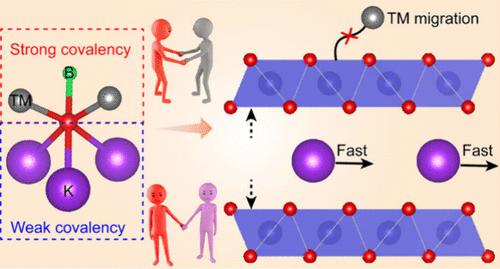在p2型层状氧化物骨架中硼配位实现持久的钾储存
IF 9.1
1区 材料科学
Q1 CHEMISTRY, MULTIDISCIPLINARY
引用次数: 0
摘要
层状过渡金属氧化物作为高能量密度钾离子电池的正极材料具有很高的应用价值。然而,由于TM - o键共价不足,不可避免地会导致TM在运行过程中发生迁移和不可逆的结构转变,从而导致速率差和长周期可靠性。为了解决这一问题,我们采用硼配位化学方法来操纵p2层K0.5Mn0.8Ni0.15B0.05O2 (KMNBO)的局部电子结构。具有高电负性的B离子驻留在TM板中,通过吸引氧周围的电子倾向来提高层状阴极的TM - o共价,从而提高了层状结构在重复k离子(脱)插入过程中的容忍度。通过减小K和o之间的库仑力,可以同时缓解K+缓慢的内在迁移。该研究打破了层状晶格的刻板印象,为开发长寿命的钾层状阴极提供了新的见解。本文章由计算机程序翻译,如有差异,请以英文原文为准。

Durable Potassium Storage Achieved by Boron Coordination in a P2-Type Layered Oxide Skeleton
Layered transition-metal (TM) oxides are of high application value as a cathode for potassium (K)-ion batteries toward high energy density. However, the inadequate covalency of the TM–O bond inevitably induces TM migration and subsequent irreversible structural transformation upon operating, which results in poor rate and long cycle reliability. To address this issue, we employed boron coordination chemistry to manipulate the local electronic structure in a prototype P2-layered K0.5Mn0.8Ni0.15B0.05O2 (KMNBO). The B ions with high electronegativity reside in the TM slabs to boost TM–O covalency of the layered cathode by attracting an electronic tendency surrounding oxygen, which upgrades the tolerance of the layered structure during the repeated K-ion (de)intercalation process. The sluggish intrinsic K+ migration could be simultaneously alleviated by reducing the Coulomb force between K and O. This study breaks the stereotype for a layered crystal lattice and provides new insight into developing long-durability potassium layered cathodes.
求助全文
通过发布文献求助,成功后即可免费获取论文全文。
去求助
来源期刊

Nano Letters
工程技术-材料科学:综合
CiteScore
16.80
自引率
2.80%
发文量
1182
审稿时长
1.4 months
期刊介绍:
Nano Letters serves as a dynamic platform for promptly disseminating original results in fundamental, applied, and emerging research across all facets of nanoscience and nanotechnology. A pivotal criterion for inclusion within Nano Letters is the convergence of at least two different areas or disciplines, ensuring a rich interdisciplinary scope. The journal is dedicated to fostering exploration in diverse areas, including:
- Experimental and theoretical findings on physical, chemical, and biological phenomena at the nanoscale
- Synthesis, characterization, and processing of organic, inorganic, polymer, and hybrid nanomaterials through physical, chemical, and biological methodologies
- Modeling and simulation of synthetic, assembly, and interaction processes
- Realization of integrated nanostructures and nano-engineered devices exhibiting advanced performance
- Applications of nanoscale materials in living and environmental systems
Nano Letters is committed to advancing and showcasing groundbreaking research that intersects various domains, fostering innovation and collaboration in the ever-evolving field of nanoscience and nanotechnology.
 求助内容:
求助内容: 应助结果提醒方式:
应助结果提醒方式:


